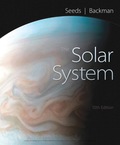
The Solar System
10th Edition
ISBN: 9781337672252
Author: The Solar System
Publisher: Cengage
expand_more
expand_more
format_list_bulleted
Question
Chapter 4, Problem 19RQ
To determine
Whether the semi major axis of mercury is greater, less or equal to distance from Sun to Mercury when Mercury is at aphelion.
Expert Solution & Answer
Want to see the full answer?
Check out a sample textbook solution
Students have asked these similar questions
Pls help ASAP
Pls help ASAP
14. A boy is out walking his dog. From his house, he walks 30 m North, then 23 m East, then 120 cm South,
then 95 m West, and finally 10 m East. Draw a diagram showing the path that the boy walked, his total
displacement, and then determine the magnitude and direction of his total displacement.
Chapter 4 Solutions
The Solar System
Ch. 4 - Prob. 1RQCh. 4 - Why did early human cultures observe astronomical...Ch. 4 - Prob. 3RQCh. 4 - Name one example each of a famous politician,...Ch. 4 - Why did Plato propose that all heavenly motion was...Ch. 4 -
On what did Plato base his knowledge? Was it...Ch. 4 - Which two-dimensional (2D) and three-dimensional...Ch. 4 - Prob. 8RQCh. 4 - In Ptolemys model, how do the epicycles of Mercury...Ch. 4 - Describe in detail the motions of the planets...
Ch. 4 - Prob. 11RQCh. 4 - Prob. 12RQCh. 4 - Prob. 13RQCh. 4 -
When Tycho observed the new star of 1572, he...Ch. 4 - Assume the night is clear and the Moons phase is...Ch. 4 - Does Tychos model of the Universe explain the...Ch. 4 - Name an empirical law. Why is it considered...Ch. 4 -
How does Kepler’s first law of planetary motion...Ch. 4 - Prob. 19RQCh. 4 - Prob. 20RQCh. 4 - Prob. 21RQCh. 4 - Prob. 22RQCh. 4 - Prob. 23RQCh. 4 - Prob. 24RQCh. 4 - Prob. 25RQCh. 4 - Prob. 26RQCh. 4 - Prob. 27RQCh. 4 - Prob. 1PCh. 4 -
If you lived on Mars, which planets would exhibit...Ch. 4 - Prob. 3PCh. 4 - If a planet has an average distance from the Sun...Ch. 4 - If a space probe is sent into an orbit around the...Ch. 4 - Prob. 6PCh. 4 - An object takes 29.5 years to orbit the Sun. What...Ch. 4 -
One planet is three times farther from the Sun...Ch. 4 - Galileos telescope showed him that Venus has a...Ch. 4 - Which is the phase of Venus when it is closest?...Ch. 4 - Prob. 11PCh. 4 - Prob. 1SPCh. 4 - Prob. 2SPCh. 4 - Prob. 1LLCh. 4 - Prob. 2LLCh. 4 - What three astronomical objects are represented...Ch. 4 - Use the figure below to explain how the Ptolemaic...
Knowledge Booster
Learn more about
Need a deep-dive on the concept behind this application? Look no further. Learn more about this topic, physics and related others by exploring similar questions and additional content below.Similar questions
- Pls help ASAParrow_forward12. A motorboat traveling 6 m/s, West encounters a water current travelling 3.5 m/s, South. a) Draw a vector diagram showing the resultant velocity, then determine the resultant velocity of the motorboat. b) If the width of the river is 112 m wide, then how much time does it take for the boat to travel shore to shore? c) What distance downstream does the boat reach the opposite shore?arrow_forwardLake Erie contains roughly 4.00⋅10114.00⋅1011 m3 of water. Assume the density of this water is 1000. kg/m3 and the specific heat of water is 4186 J/kg˚C. It takes 2.31x10^19 J of energy to raise the temperature of that volume of water from 12.0 °C to 25.8 ˚C. An electric power plant can produce about 1110 MW. How many years would it take to supply this amount of energy by using the 1110 MW from an electric power plant?arrow_forward
- Pls help ASAParrow_forwardPls help ASAParrow_forwardm m $2° 15. A truck is stopped at a red light. Once the light turns green, the truck accelerates forward at 1.75- that same instant, a car moving with a constant speed of 50 — passes the truck. a) How many seconds will it take for the truck to catch up to the car? S b) How many metres will the truck travel before it catches up to the car? Atarrow_forward
- Pls help ASAParrow_forwardI need help adding more information to my study guide. This is subject is physics My topic : Emission Spectrum Target Material I need information on this topic but make it as study guide form and make 5 questions and include the answers.arrow_forwardAn electron and a proton are each moving at 755 km/s in perpendicular paths as shown in (Figure 1). Find the magnitude of the total magnetic force that the electron exerts on the proton. Find the magnitude of the total electrical force that the electron exerts on the proton.arrow_forward
arrow_back_ios
SEE MORE QUESTIONS
arrow_forward_ios
Recommended textbooks for you
 Foundations of Astronomy (MindTap Course List)PhysicsISBN:9781337399920Author:Michael A. Seeds, Dana BackmanPublisher:Cengage Learning
Foundations of Astronomy (MindTap Course List)PhysicsISBN:9781337399920Author:Michael A. Seeds, Dana BackmanPublisher:Cengage Learning Stars and Galaxies (MindTap Course List)PhysicsISBN:9781337399944Author:Michael A. SeedsPublisher:Cengage Learning
Stars and Galaxies (MindTap Course List)PhysicsISBN:9781337399944Author:Michael A. SeedsPublisher:Cengage Learning
 Physics for Scientists and Engineers: Foundations...PhysicsISBN:9781133939146Author:Katz, Debora M.Publisher:Cengage Learning
Physics for Scientists and Engineers: Foundations...PhysicsISBN:9781133939146Author:Katz, Debora M.Publisher:Cengage Learning Principles of Physics: A Calculus-Based TextPhysicsISBN:9781133104261Author:Raymond A. Serway, John W. JewettPublisher:Cengage Learning
Principles of Physics: A Calculus-Based TextPhysicsISBN:9781133104261Author:Raymond A. Serway, John W. JewettPublisher:Cengage Learning

Foundations of Astronomy (MindTap Course List)
Physics
ISBN:9781337399920
Author:Michael A. Seeds, Dana Backman
Publisher:Cengage Learning

Stars and Galaxies (MindTap Course List)
Physics
ISBN:9781337399944
Author:Michael A. Seeds
Publisher:Cengage Learning


Physics for Scientists and Engineers: Foundations...
Physics
ISBN:9781133939146
Author:Katz, Debora M.
Publisher:Cengage Learning

Principles of Physics: A Calculus-Based Text
Physics
ISBN:9781133104261
Author:Raymond A. Serway, John W. Jewett
Publisher:Cengage Learning

Kepler's Three Laws Explained; Author: PhysicsHigh;https://www.youtube.com/watch?v=kyR6EO_RMKE;License: Standard YouTube License, CC-BY